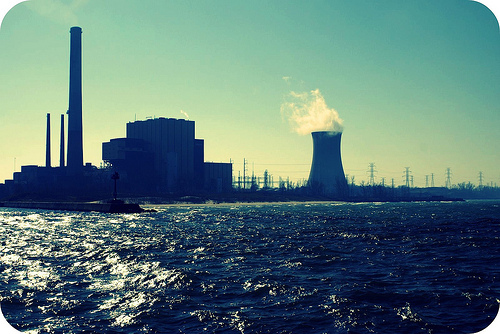|
Two Meltdowns: Fukushima and
the US Economy

Fukushima Nuclear Crisis
Magnetic Field Detector
More than a year after a tsunami swamped the
Fukushima-Daiichi nuclear power plants, the radiation
peril continues -- reactor 4 is teetering on the edge of
collapse, which would force the evacuation of one-third of
Japan's population. The meltdown at Fukushima parallels the
meltdown of the US economy.
On March 11, 2011, Japan experienced a 9.0 earthquake. The
six nuclear plants at Fukushima -- about 136 miles north of
Tokyo -- survived the quake but were swamped by a 45-foot
wave that overwhelmed the 19-foot seawalls. Fukushima units
5 and 6 were in cold shutdown for maintenance and Unit 4 had
been deactivated. Units 1,2, and 3 lost power and were
unable to cool down properly; they experienced full
meltdown. This was a catastrophe but there was a robust
containment system that minimized the spread of
contamination.
As part of the maintenance process, the 1535 fuel rods in
Fukushima reactor 4 had been removed and placed in a pool of
water outside the containment system. The aftermath of the
tsunami severely damaged the building. This April, Senator
Ron Wyden toured Fukushima and warned that another big
earthquake could further damage unit 4, producing "an even
greater release of radiation than the initial accident."
(Since March 11, more than 1000 significant earthquakes
have struck Japan.) In January at the World Economic Forum
in Davos, Switzerland, former Japanese Prime Minister Naoto
Kan warned of the possibility of a nuclear disaster and
said that a meltdown at unit 4 would force the evacuation of
Tokyo and close half of Japan. (On April 15th, the European
Union Times reported that the Japanese government had
engaged with in discussions with China and Russia about the
migration of 40 million Japanese because of the "extreme
danger of life threatening radiation poisoning.")
The United States is not facing a nuclear crisis, but we are
struggling with an economic crisis. The meltdown at
Fukushima helps clarify our own meltdown.
The saga of Fukushima-Daiichi follows the famous arc of the
failed project : unwarranted enthusiasm followed by
unmitigated disaster and then random retribution (search for
the guilty, punishment of the innocent, and promotion of the
uninvolved).
After the atomic bombing of Hiroshima and Nagasaki, the
Japanese were not enthusiastic about nuclear power. As
chronicled by New Yorker writer Evan Osnos , the United
States decided to convince Japan to build a nuclear power
plant. After a twenty-year campaign, public attitude shifted
and nuclear power was embraced as "the fire of hope in the
twenty-first century." Japan powered up Fukushima unit 1 on
October 10, 1970, and built 53 more reactors. An atomic cult
assured citizens that nuclear power was safe. Enos observed,
"The myth of total safety went beyond public relations and
degraded the [nuclear] industry's technical competence."
After the Great Depression, Americans were not enthusiastic
about going into debt or giving too much power to the
financial sector. Beginning in 1980, President Reagan
convinced Americans that we did not have to sacrifice in
order to have a good life and we began to believe we could
borrow our way to riches. Reagan also convinced Americans
there was no need for financial regulations and one-by-one
all the depression-era safeguards were eliminated. An
economic cult, the Chicago School of Economics promoted
deregulation by arguing that markets were inherently
self-regulating and no matter how severe the setback,
markets would quickly return to equilibrium.
In both cases, unwarranted enthusiasm led to unmitigated
disaster. Fukushima-Daiichi was a level 7 nuclear event --
the most serious since 1986's Chernobyl meltdown and
potentially the most serious in history.
The US economic disaster began in 2000, with a housing
bubble where prices increased astronomically and millions of
investors rushed into the market. In 2007, the bubble burst
as prices plummeted and investors defaulted. On September
15, 2008, the Lehman Brothers investment bank filed for
bankruptcy, causing a global financial panic. On September
18th, the Bush Administration presented an outline of a
bank bailout plan to Congressional leaders, but the damage
had been done: the US economy had experienced a meltdown.
In both cases, unmitigated disaster was followed by random
retribution and little change. The Japanese government
consistently understated the gravity of the situation -- it
took them four months to admit that a meltdown had occurred
in Fukushima reactors 1,2, and 3. Prime Minister Kan was
replaced but his successor, Yoshihiko Noda, restarted
nuclear plants and 36 continue to be used.
In December 2008, one month after the US presidential
election, the Bush administration admitted that America had
been in a recession since December of 2007. In February of
2009, Democrats passed an economic stimulus bill, but when
the economy did not quickly rebound, Republicans began to
blame Democrats for America's economic woes. The 2012
Republican presidential candidate, Mitt Romney, claims that
it is President Obama's fault that "America is not working."
Meanwhile the financial institutions that caused the
meltdown have grown more powerful.
Japan's nuclear tragedy and America's economic crisis follow
the same tragic pattern: A naļve population was seduced by a
cult and abandoned common sense. That resulted in a
meltdown. In the aftermath, a confused electorate didn't
understand what had happened, accepted bad advice, and
little changed. Paving the way for another meltdown.
http://www.emfnews.org/store |
